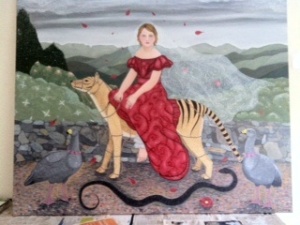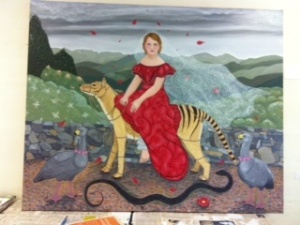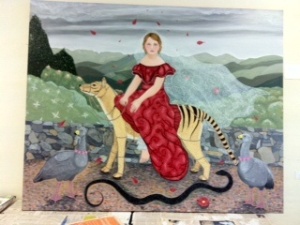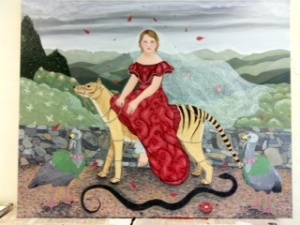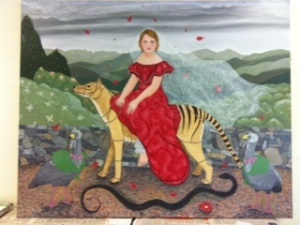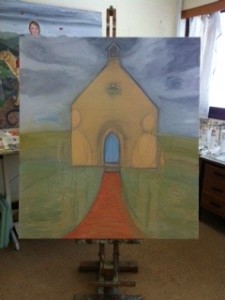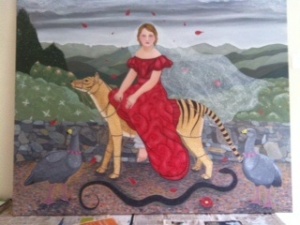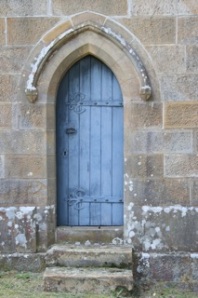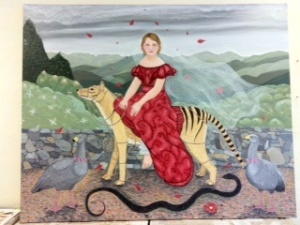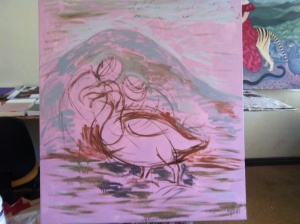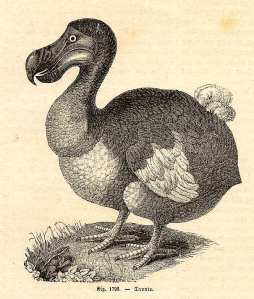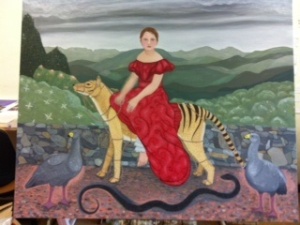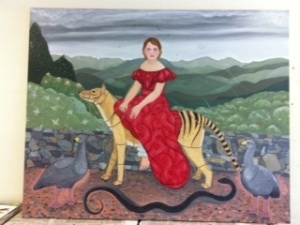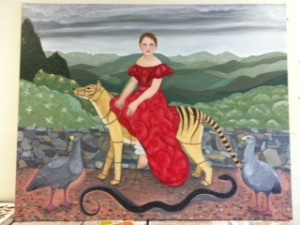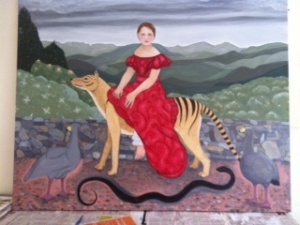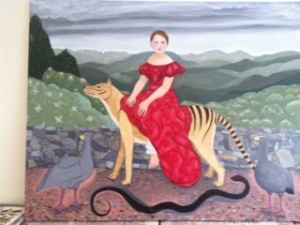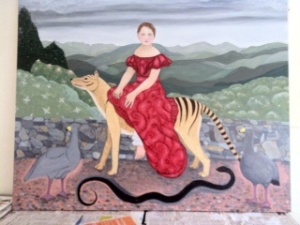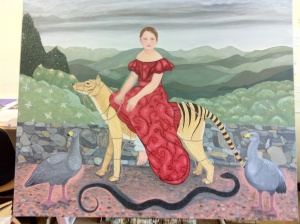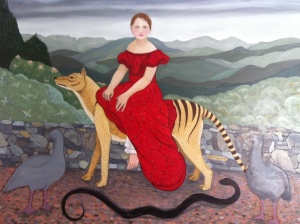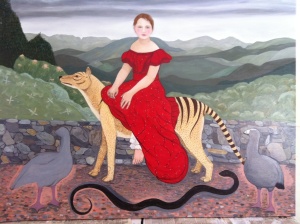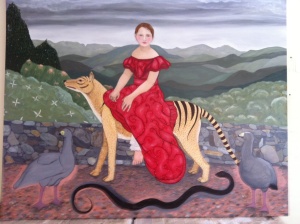The good news is that my latest painting, the Tiger Bride, is almost finished. The bad news is that the human propensity to fiddle is potentially endless. And so it is that I have been hovering over the canvas with a tiny brush, making minute changes that no-one is likely to notice. Or even if they did notice, it’s doubtful whether it would make any difference to their reading of the image. Still, one is compelled to fiddle, even though there has to be a point where you say ‘enough! the bloody thing is finished’.
So why all the last minute angsting over trivial details of virtually nil visual impact? A good question! It’s partly a desire to make the painting as whole as it can be. When I get to this point in a painting, the big decisions are no longer clear (such as where the large forms go and what they look like). It’s just thousands of tiny little decisions that could go one way or the other. For example, does the veil need some ribbons blowing around it to increase the sense of dynamism? It’s essentially quite a static image, painted with small, tight brushstrokes, and the ribbons could help add movement. Or flow.
And if I add more detail to the Cape Barren Geese, will this help jump them forward into the foreground? At the moment they’re hovering tonally on the same plane as the stone wall. If I do add detail, what do I add? I had this idea of dressing them in natty little green velvet capes with lace bonnets. But if I do this, will it look incorrigibly naff? More specifically, will it take the image too far down the road towards children’s book illustration, bringing a kind of Wind in the Willows tendency into something that is supposed to be pretty but also ambiguous and hopefully potent.
As you can see, the green velvet capes, complete with frilly neck-lines, made the cut. Their colour (chromium oxide) is too buzzy, much too high a key for the rest of the painting, so next time I’m in the studio I’ll calm them down with a pale tint.
The other reason why it’s sometimes hard to finish paintings is more oblique. One gets so fond of them, they dominate your thoughts for a period of time, and it’s hard to let go. I’m visually monogamous: I like working intensely on just one image at a time. I find that flicking between images, though productive, dilutes the intensity required to make anything good. But this is just me, everyone works differently.
I am however fine with working up the underpainting layers of other canvases while I’m concentrating on one main image. This is a shot of a painting, I’ve nicknamed it church, that will eventually show a small, squat colonial era church with two children at the front, possibly holding animals. I return to this image, again and again, which is odd as I don’t even particularly like American Gothic.
In a moment of clarity in the studio yesterday, I worked out that most of my images talk about female power. I was musing about the church image, and thinking that I may try painting a 3/4 view of the building, showing some nice sandstone details along the side. But for some reason I couldn’t break away from the image of the church, with a centrally placed door, and a curving path leading up to the entrance. Eventually I decided that the door acts as a kind of female phallic symbol, both a literal and a metaphorical gateway.
This is the photograph, of a Tasmanian church, that I’m using as reference. There’s something terribly mawish about this door.
In other news, I’ve repainted the background to the Dodo with children in snowstorm image (it will probably have a better title eventually, but that’s its working name). I wanted the three figures to form a triangle, and visually operate as a pieta, with the human figures a descending series of forms curved over the dodo, the solid base of the triangle. Anyway, the whole group was off centre, and it wasn’t working.
I also abandoned my plan to paint a mountain, Hobart’s Mount Wellington, in the background. Firstly because I didn’t have decent reference material (despite my many trips to Tasmania to gather reference material, I had somehow forgotten to photograph the mountain that looms over the small city). And secondly because it would have closed in the pictorial space at a time when I’m trying to open it up and play with depth.
Here’s the underpainting of another image, it will eventually depict two girls standing on a beach, wearing colonial era ball gowns and animal masks. One will have her hands raised, pushing the mask off her face (perceiving the history of the place), a pose that dates back, at least in my imagination, to Les Demoiselles d’Avignon. I’m looking forward to this painting, imagining it as gelato coloured, all light pink, olive green, white and pale grey.
Surprisingly, one of my favourite parts of Tiger Bride was painting the lace. If you get up close, there’s some quite odd symbols and patterns woven into the pattern, including Pacific tribal motifs and things that look like crop circles. In retrospect, the lace looked better when parts of it were left sheer, as opposed to covered with ’embroidery’, but I went a bit OCD and didn’t notice this until I’d finished. At this stage I thinking that I can use lace as the visual motif that ties this exhibition together: I like the way it both obscures and consolidates forms. Incidentally the exhibition that these paintings are for, Strange Tales, has been moved back a couple of months. It will now open at Despard Gallery, Tasmania, in late April 2012.
